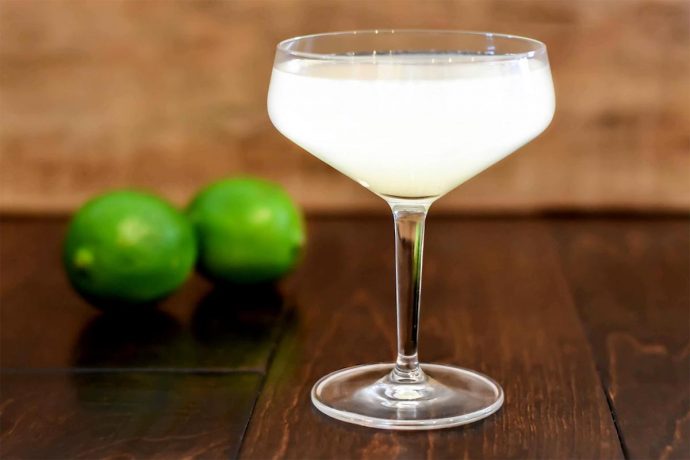It’s hard to find a more user-friendly drink than the Daiquiri. All it takes is some quality white rum, fresh lime juice, and a little sugar for even the greenest of home bartenders to make a quality cocktail.
That same simplicity is what makes it endlessly versatile. We spoke to Kevin Martin, VP of Sales at Privateer Rum, to learn all the ways you can shake up your Daiquiri game this summer, from blending rums to mixing jams and much, much more.
Find Your Ratio
The most classic ratio for making Daiquiris is two parts rum, one part lime juice, and one part sugar.
“When we teach cocktail classes, that’s what we teach,” says Martin. “It’s not sweet, it’s not sour, it’s not too strong. It’s balanced in every way.”
But don’t feel that you can’t deviate from the 2:1:1 build. Small tweaks can better suit certain taste preferences.
“2:¾:¾ is more spirit-forward, and definitely more rummy. And 2:¾:½ is for the person who wants to avoid anything on the sweeter side,” Martin says.
Don’t Be Afraid to Mix Rums
“What one rum can’t do, three rums can,” says Martin, quoting tiki godfather Don The Beachcomber.
Martin suggests mixing like with unlike, such as blending a silver rum with an aged rum, a pot-still rum, or a rhum agricole.
“When you blend rum together, you get the best of what each rum has to offer,” he says. “With aged rums you get those roasted notes, candied fruit notes, maybe more savory notes. With silver rums, especially with our rum, it’s more of the fresher flavors, tropical and pineapple, a little bit of orange zest.”
Martin suggests blending rums with a 1:1 ratio as a starter, but suggests a 3:1 ratio if you’re blending a more standard-proof rum with something overproof, or a particularly pungent pot-still.

Kevin Martin, Privateer Rum
Get Rich
The most obvious way to tweak the sweet element is to use a rich simple syrup, which is made with a 2:1 ratio of sugar and water rather than the traditional 1:1 blend. If you decide to go this route, which adds less water to the drink and gives the syrup a more rounded character, Martin suggests tweaking the Daiquiri build to two parts rum, 3/4 lime, and 1/2 sugar.
Unrefined brown sugar, which is closer to molasses, makes for a less sweet, more flavorful rich simple syrup.
“You get all of those cooked fruit notes, more molasses, more baking spice, more depth of flavor,” Martin says.
Go Straight To The Source
Molasses itself can be a great sweetener, so long as you don’t mind its cosmetic effect.
“It does not make what some people would call an attractive colored drink. But if you are really into Daiquiris then it shouldn’t matter,” says Martin.
Undiluted maple syrup can be used in place of simple syrup, as is the case with Privateer’s New England Daiquiri, which follows a 2:1:1 build.
Spice Up Your Syrup
Spiced syrups can be created with cinnamon, clove, allspice, or even Sichuan peppercorn. While the flavors themselves may prove more exotic, the cooking process isn’t much different. The key is to crush the spices and toast them in the pan to extract flavor.
“Then I throw my water in, and I throw my sugar in, and it’s a one pot deal,” Martin says.
Try Cranberries and Coconut
For an easier hit of flavor, Martin makes cranberry syrup using a technique he learned from veteran bartender Ben Sandroff of Boston cocktail bar, Drink.
“He taught me that if you take Ocean Spray cranberry juice and you dissolve that one-to-one with sugar, you can make a cranberry syrup out of it,” Martin says.
Martin admits that his favorite way to sweeten a Daiquiri is with toasted coconut syrup, which can be made by lightly toasting coconut in a pan with equal parts water and white or brown sugar.
“Toasted coconut and brown sugar syrup? Phenomenal. My mouth is watering just thinking about it,” he says.

Privateer Rum Daiquiri courtesy of Kevin Martin.
Experiment With Mix-Ins
“Now we’re really starting to push the envelope of whether this is a Daiquiri anymore, but to each their own,” Martin says of adding “mix-ins” like fruit jams and herbs to a Daiquiri.
“Having fresh fruits is very expensive, and depending on your environment can attract fruit flies,” he says.
His solution is to add a single barspoon of locally made jam (or the excellent French brand Bonne Maman) to a traditional 2:1:1 Daiquiri build just before shaking. You’ll have a raspberry or Strawberry Daiquiri in no time—and no mess to clean up after.
“When you’re done you seal up that jar, no fruit flies, spoilage is to a minimum, and you’ve accomplished everything that you’re looking for,” Martin says.
A similarly easy practice is to toss a handful of herbs into a Daiquiri-filled shaker. Martin enjoys using “hard herbs” like rosemary and thyme in the winter, and “soft herbs” like mint in the summer. Just be careful when using mint—you may accidentally end up with another popular cocktail on your hands.
“If you take a Daiquiri recipe and you shake mint into it, and then instead of straining it you pour the contents and top it with soda water, you’ve got a Mojito,” Martin says.
Get Bitter
For Daiquiri variants that require next to no effort to achieve, simply add a few dashes of bitters before shaking. Martin suggests Angostura bitters, grapefruit bitters, and Hellfire bitters, or even a combination of Angostura and Regan’s Orange.
“Anything that you put in there is going to change the flavor. That’s what’s great about Daiquiris,” Martin says.



